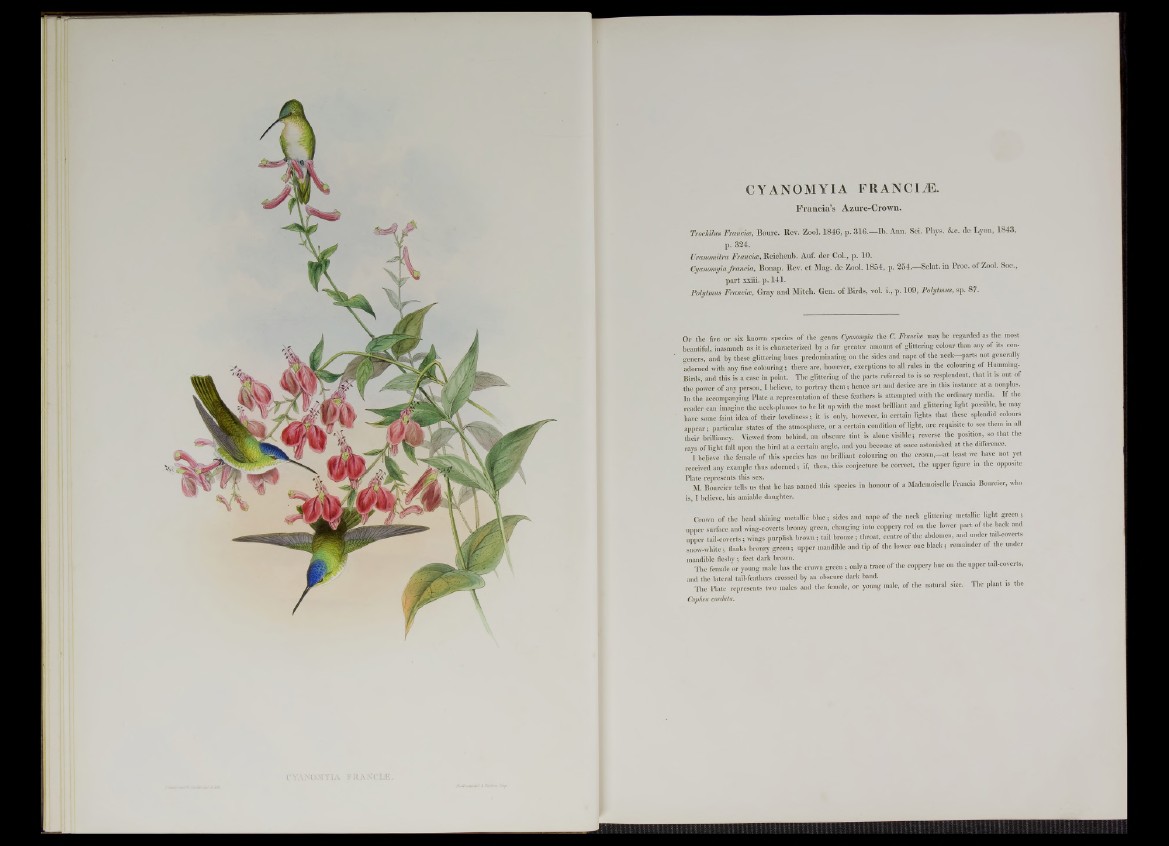
CYANOMYIA FRANCIÆ.
Francia’s Azure-Crown.
TrocMlm Francité, Bourc. Rev. Zool. 1846, p. 316.—lb . Ann. Sci. Phys. &c. de Lyon, 1843,
p. 324.
XJranomitra Francité, Reichenb. Auf. der Col., p. 10.
Oyanomyia francia, Bonap. Kev. e t Mag. de Zool. 1854, p. 254.—Sclat. in Proc. of Zool. Soc.,
p a rt xxiii. p. 141.
PoTytmm Francité, Gray and Mitch. Gen. of Birds, vol. i., p. 109, Pobjtmm, sp. 87.
Or the five or six known species of the genns Ct/tmtmyia the C. Francite may be regarded as the most
beautiful, inasmuch as it is characterized by a far greater amount of glittering colour than any of its congeners,
and by these glittering hues predominating on the sides and nape of the neck parts not generally
adorned with any fine colouring; there are, however, exceptions to all rules in the colouring of Humming-
Birds, and this is a case in point. The glittering of the parts referred to is so resplendent, that it is out of
the power of any person, I believe, to portray them; hence art and device are in this instance at a nonplus.
In the accompanying Plate a representation of these feathers is attempted with the ordinary media. If the
reader can imagine the neck-plumes to be lit np with the most brilliant and glittering light possible, he may
have some faint idea of their loveliness; it is only, however, in certain lights that these splendid colours
appear; particular states of the atmosphere, or a certain condition of light, are requisite to see them in all
their brilliancy. Viewed from behind, an obscure tint is alone visible; reverse the position, so that the
rays of light fall upon the bird at a certain angle, and yon become at once astonished at the difference.
I believe the female of this species has no brilliant colouring on the crown,—a t least we have not yet
received any example thus adorned; if, then, this conjecture be correct, the upper figure in the opposite
Plate represents this sex. _ .
M. Bourcier tells us that he has named this species in honour of a Mademoiselle Francia Bourcier, who
is, I believe, his amiable daughter.
Crown of the head shining metallic blue; sides and nape of the neck glittering metallic light green ;
upper surface, and wing-coverts bronzy green, changing into coppery red on the lower part of the back and
upper tail-coverts; wings purplish brown; tail bronze; throat, centre of the abdomen, and under tail-coverts
snow-white; flanks bronzy green; upper mandible and tip of the lower one black; remainder of the under
mandible fleshy ; feet dark brown.
The female or yonng male has the crown green ; only a trace of the coppery hue on the upper tail-coverts,
and the lateral tail-feathers crossed by an obscure dark band.
The Plate represents two males and the female, or young male, of the natural size. The plant is the
Cuphea cordata.